The human immunodeficiency virus type 1 promoter contains a CATA box instead of a TATA box for optimal transcription and replication
- PMID: 15194764
- PMCID: PMC421681
- DOI: 10.1128/JVI.78.13.6883-6890.2004
The human immunodeficiency virus type 1 promoter contains a CATA box instead of a TATA box for optimal transcription and replication
Abstract
The human immunodeficiency virus type 1 (HIV-1) transcriptional promoter contains a single polymorphism in the TATA box. Most subtypes contain the sequence TATAAGC, but subtype E and some recombinant AG strains have the sequence TAAAAGC. Based on mutagenesis studies of cellular RNA polymerase II (pol II) promoters, it has been proposed that the subtype E TATA box is nonfunctional due to the T-to-A substitution at the critical position 3. By means of transcription and virus replication assays, we demonstrate that the true TATA box motif within the viral long terminal repeat (LTR) promoter starts two nucleotides further upstream. Because of this realignment, subtype E has the sequence CATAAAA and all other subtypes have the sequence CATATAA. The polymorphism therefore has shifted from position 3 to position 5 and is no longer incompatible with efficient transcription according to rules determined for cellular pol II promoters. In addition, through sensitive competition experiments, we demonstrate that the CATA box of subtypes B and E can be improved for replication by the mutations 1T and 5T, respectively. The fact that the fitness of both subtype LTRs can be increased by specific point mutations in the CATA box suggests that the transcriptional promoter of HIV-1 is fine-tuned towards a suboptimal level of replication. However, this replication rate may be optimal in the in vivo context of an infected individual.
Figures

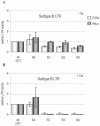
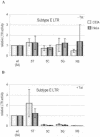

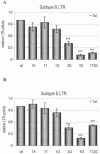
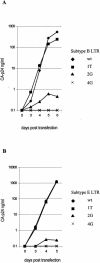
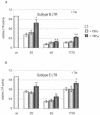
Similar articles
-
Functional differences between the long terminal repeat transcriptional promoters of human immunodeficiency virus type 1 subtypes A through G.J Virol. 2000 Apr;74(8):3740-51. doi: 10.1128/jvi.74.8.3740-3751.2000. J Virol. 2000. PMID: 10729149 Free PMC article.
-
Analysis of factors influencing kinetics of herpes simplex virus transcription utilizing recombinant virus.Methods. 1998 Sep;16(1):105-16. doi: 10.1006/meth.1998.0648. Methods. 1998. PMID: 9774520
-
The most frequent naturally occurring length polymorphism in the HIV-1 LTR has little effect on proviral transcription and viral replication.Virology. 2002 Jan 5;292(1):169-75. doi: 10.1006/viro.2001.1282. Virology. 2002. PMID: 11878920
-
The human immunodeficiency virus LTR-promoter region as a reporter of stress-induced gene expression.Methods Mol Biol. 2000;99:277-95. doi: 10.1385/1-59259-054-3:277. Methods Mol Biol. 2000. PMID: 10909090 Review. No abstract available.
-
Promoter architecture and the evolvability of gene expression.J Biol. 2009;8(11):95. doi: 10.1186/jbiol204. Epub 2009 Dec 14. J Biol. 2009. PMID: 20017897 Free PMC article. Review.
Cited by
-
CTGC motifs within the HIV core promoter specify Tat-responsive pre-initiation complexes.Retrovirology. 2012 Jul 26;9:62. doi: 10.1186/1742-4690-9-62. Retrovirology. 2012. PMID: 22834489 Free PMC article.
-
Regulation of human immunodeficiency virus type 1 gene expression by clade-specific Tat proteins.J Virol. 2005 Jul;79(14):9180-91. doi: 10.1128/JVI.79.14.9180-9191.2005. J Virol. 2005. PMID: 15994812 Free PMC article.
-
Loss of In Vivo Replication Fitness of HIV-1 Variants Resistant to the Tat Inhibitor, dCA.Viruses. 2023 Apr 12;15(4):950. doi: 10.3390/v15040950. Viruses. 2023. PMID: 37112931 Free PMC article.
-
FUBP3 enhances HIV-1 transcriptional activity and regulates immune response pathways in T cells.Mol Ther Nucleic Acids. 2025 Mar 25;36(2):102525. doi: 10.1016/j.omtn.2025.102525. eCollection 2025 Jun 10. Mol Ther Nucleic Acids. 2025. PMID: 40248217 Free PMC article.
-
Effects of random mutations in the human immunodeficiency virus type 1 transcriptional promoter on viral fitness in different host cell environments.J Virol. 2006 Jul;80(13):6678-85. doi: 10.1128/JVI.02547-05. J Virol. 2006. PMID: 16775355 Free PMC article.
References
-
- Albright, S. R., and R. Tjian. 2000. TAFs revisited: more data reveal new twists and confirm old ideas. Gene 242:1-13. - PubMed
-
- Auersperg, N. 1964. Long-term cultivation of hypodiploid human tumor cells. J. Natl. Cancer Inst. 32:135-163. - PubMed
-
- Berkhout, B., A. Gatignol, A. B. Rabson, and K. T. Jeang. 1990. TAR-independent activation of the HIV-1 LTR: evidence that tat requires specific regions of the promoter. Cell 62:757-767. - PubMed
-
- Blackard, J. T., B. Renjifo, W. Fawzi, E. Hertzmark, G. Msamanga, D. Mwakagile, D. Hunter, D. Spiegelman, N. Sharghi, C. Kagoma, and M. Essex. 2001. HIV-1 LTR subtype and perinatal transmission. Virology 287:261-265. - PubMed
Publication types
MeSH terms
Substances
LinkOut - more resources
Full Text Sources

